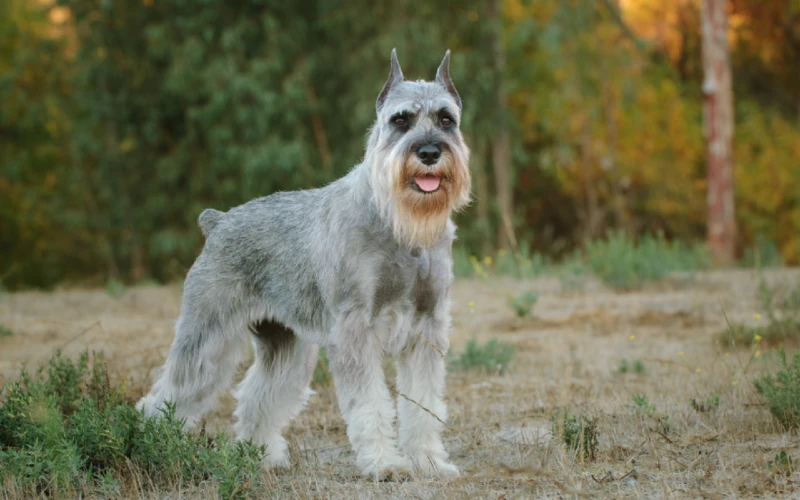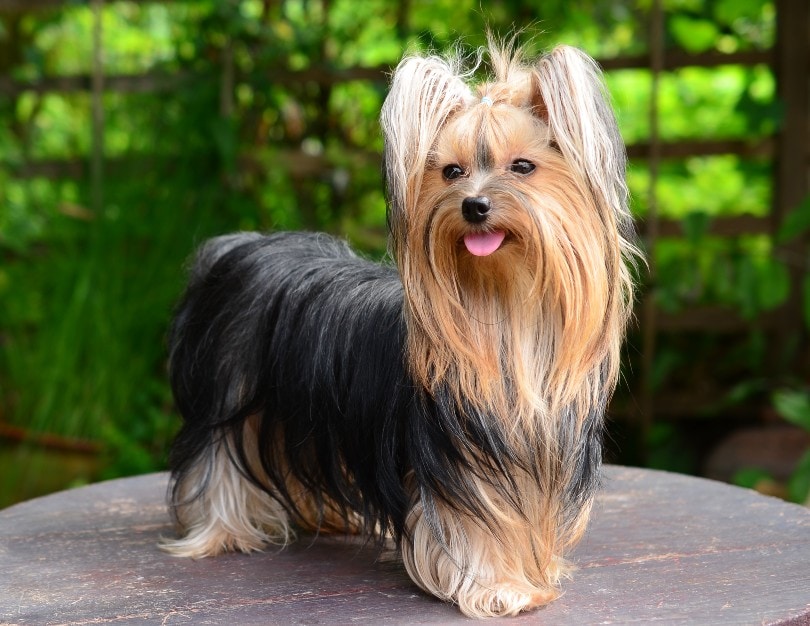If you have a dog with Cushing’s disease, it’s important to educate yourself on the condition they’re living with. Medically known as hyperadrenocorticism,1 Cushing’s disease is a condition whereby either the pituitary gland or the adrenal glands, cause an overproduction of the hormone cortisol. It occurs more commonly in senior dogs than humans or cats and is often caused by a tumor on the pituitary gland or adrenal gland, but not always.
Cushing’s disease is commonly seen in smaller dog breeds as they tend to be at a higher risk for this condition than larger breeds, but large dog breeds aren’t exempt. Although it’s clear that certain breeds are more at risk for this disease,2 there is no clear reason why.
Keep reading as we discuss the various dog breeds that are prone to Cushing’s disease, what the different causes are, and what signs to look out for if you’re concerned about your dog’s health.

The 8 Dogs Prone To Cushing’s Disease
1. Standard Schnauzer

The Schnauzer comes in miniature, standard and giant sizes. These medium sized dogs are known for their full beards and eyebrows with upward curling tails. They enjoy exercise and require it daily to prevent boredom and undesirable behavior. Originally used for ratting and guarding on German farms they are now a common companion breed.
The standard Schnauzer is significantly (58 times) more likely to develop Cushing’s disease than cross breeds according to a 2019 study.3 Coming at the top of the list. They also have a higher than usual tendency to develop pancreatitis, hip dysplasia and follicular dermatitis.
2. Boxers

Boxers are muscular dogs that are highly loyal and somewhat needy for companionship. If you are an active person, this breed is a great option for you because they require plenty of exercise and will love to take part in activities with the family. They’re playful and silly but take being the family guardian seriously. They make great watch-dogs because they’re alert, protective, and brave but are patient enough for young children.
However, they are prone to quite a few health conditions and don’t tend to live past 10 years. Their sweet, flat faces can make breathing and regulating their body temperature difficult, which can cause them to overheat in hot weather. They commonly suffer from hip dysplasia, heart problems, thyroid issues, certain cancers, and are much more prone to Cushing’s disease, 7.6 times more likely than cross breeds.
3. Miniature Dachshunds

Dachshunds are sweet little dogs that have short legs, long bodies, and floppy ears. They’re great watch-dogs as they are alert, brave, independent, and have a big bark. They’re eager for anything but can’t be expected to run long distances. Their coats are short to medium in length, smooth, and don’t shed much. They’re easy to groom but require extra care in other areas, such as their diet.
These little dogs can become overweight and are around 3.5 times more likely to develop Cushing’s disease. Because they’re prone to intervertebral disc disease, you’ll also need to teach them not to jump onto or off your furniture, as it can also cause injury and paralysis.
4. Yorkshire Terriers

Everyone knows the Yorkshire Terrier for their tiny size and their long, silky hair that is often tied up into a bow. What many people don’t know is that they’re one of the breeds that have a higher risk of developing Cushing’s disease around 3.43 times the risk of a crossbreed. These little dogs are affectionate and will happily fall asleep against your side or on your lap. However, they’re also a lot of fun and have strong personalities.
Unlike the two previous dog breeds on our list, the Yorkshire terrier requires much more effort in the grooming department, as their long hair needs to be brushed regularly and trimmed occasionally. Their strong personalities and stubbornness make them a little harder to train, and they have a tendency to be a bit snappy when they feel anxious. They are prone to several health problems such as luxating patella, collapsing trachea and porto-systemic shunts amongst others.
5. Poodles

You will find Poodles in three different sizes: Standard, Miniature, and Toy. All size varieties are prone to Cushing’s disease, but there is a higher risk in the two smaller sizes (3.4 times the risk in miniature poodles). Poodles are also prone to epilepsy, Von Willebrand’s disease, cardiomyopathy, Addison’s disease, intervertebral disc disease, hypothyroidism, luxating patellas, and a few others. Before taking on a Poodle, it’s important to be aware that they may develop one of these conditions and to prepare yourself for it.
Poodles are obedient, incredibly intelligent, and easy to train. They love to run, retrieve, swim, and jump and are known to jump over walls, so you’ll need to train them not to. These elegant dogs have stunning coats that set them apart from many other breeds, but with that comes a lot of responsibility as they need to be groomed regularly.
6. Cavalier King Charles Spaniels

Cavalier King Charles Spaniels are gorgeous dogs, thanks to their long coats, lush eyelashes, and long, floppy ears. The breed boasts a wide variety of coat colors and requires regular grooming as they can become matted quickly. These dogs love playtime and will burn off their built-up energy through games such as fetch, going on walks, and playing with their families. They love to please their owners and are pretty easy to train although some are a bit stubborn. They make lovely companion dogs for families with young children and the elderly alike.
Unfortunately Cavalier King Charles Spaniels commonly struggle with a variety of health problems. These little dogs are also prone to Cushing’s disease (8 times more likely) as well as heart and neurological problems in particular.
7. Beagles

Beagles are another medium-sized dog breed with long, floppy ears that are slightly more prone to Cushing’s disease (0.65 times more likely). They’re excellent companions and love being in households with other members and pets. They don’t make great guard dogs because they’re simply too friendly! They’re also loving, clever, and energetic, making them a fun breed to have. However, they need plenty of attention, exercise, and stimulation. Without it, they can become destructive, will bark excessively, and look for entertainment.
As with all dogs with long, floppy ears, Beagles are prone to ear infections. They’re also at risk for hip dysplasia, allergies, hypothyroidism, cherry eye, luxating patellas, and epilepsy. They also love food and can become overweight, which causes further health problems and issues with their joints.
8. Boston Terriers

Boston terriers are small dogs and are on the list of breeds more likely to get Cushing’s disease. They make wonderful companions, have plenty of energy, and love to interact through play. They’re a great breed for families with children and other pets, as they’re pretty easygoing. They don’t require excessive grooming or exercise and are easy to train, although they can be stubborn.
As wonderful as this breed is to have around, they do require a little more care than some other breeds. They tend to have delicate digestive systems and may require a specific diet for it. Their short, flat faces make them prone to breathing problems and brachycephalic obstructive airway syndrome (BOAS), and they can overheat easily, so you shouldn’t leave them outside for long.
What Causes Cushing’s Disease in These Breeds?
Cushing’s disease is most common in older dogs and neutered females and is caused by an excess of cortisol in the body. This increase in cortisol is harmful to dogs because it can cause other health problems such as high blood pressure, kidney problems, bladder stones, liver changes, clotting problems, diabetes, and chronic urinary tract infections.
A dog with Cushing’s disease needs to be examined, diagnosed, and treated by a veterinarian. Dogs in treatment often go on to live another 2–4 years and often die due to age-related causes instead of Cushing’s disease.
A few things can cause Cushing’s disease in dogs, such as a tumor (usually benign) on the pituitary gland, a tumor on one of the adrenal glands, or long-term steroid use. The first cause is the most common. The type of treatment your vet gives your dog will depend on the type of Cushing’s disease they have.
Signs of Cushing’s Disease
As your dog gets older, they have a higher risk of developing Cushing’s disease, as it’s most common in senior dogs, especially in the breeds listed above. However, it takes time before you’ll be able to spot signs of this condition.
- Increased appetite
- Increased thirst
- Increased urination
- Lethargy
- Excessive panting
- Hair loss
- Fragile skin
- Blackheads
- Sudden blindness
- Recurrent skin infections
- Abnormally large abdomen (pot belly)


Conclusion
Cushing’s disease can cause serious health problems in your dog and needs to be managed and treated by a vet. Although there isn’t scientific evidence why, certain dogs are prone to developing this condition, and of those breeds, most of them are small to medium in size.
Cushing’s disease is common in Schnauzers, Boxers, Dachshunds, Yorkshire terriers, Poodles, Cavalier King Charles Spaniels, Beagles, and Boston Terriers. It’s important to regularly take your dog to the vet for checkups to catch this condition early.
- Related Read: 7 Dogs Prone to Diabetes: Vet Reviewed Breeds
Featured Image Credit: Eve Photography, Shutterstock










